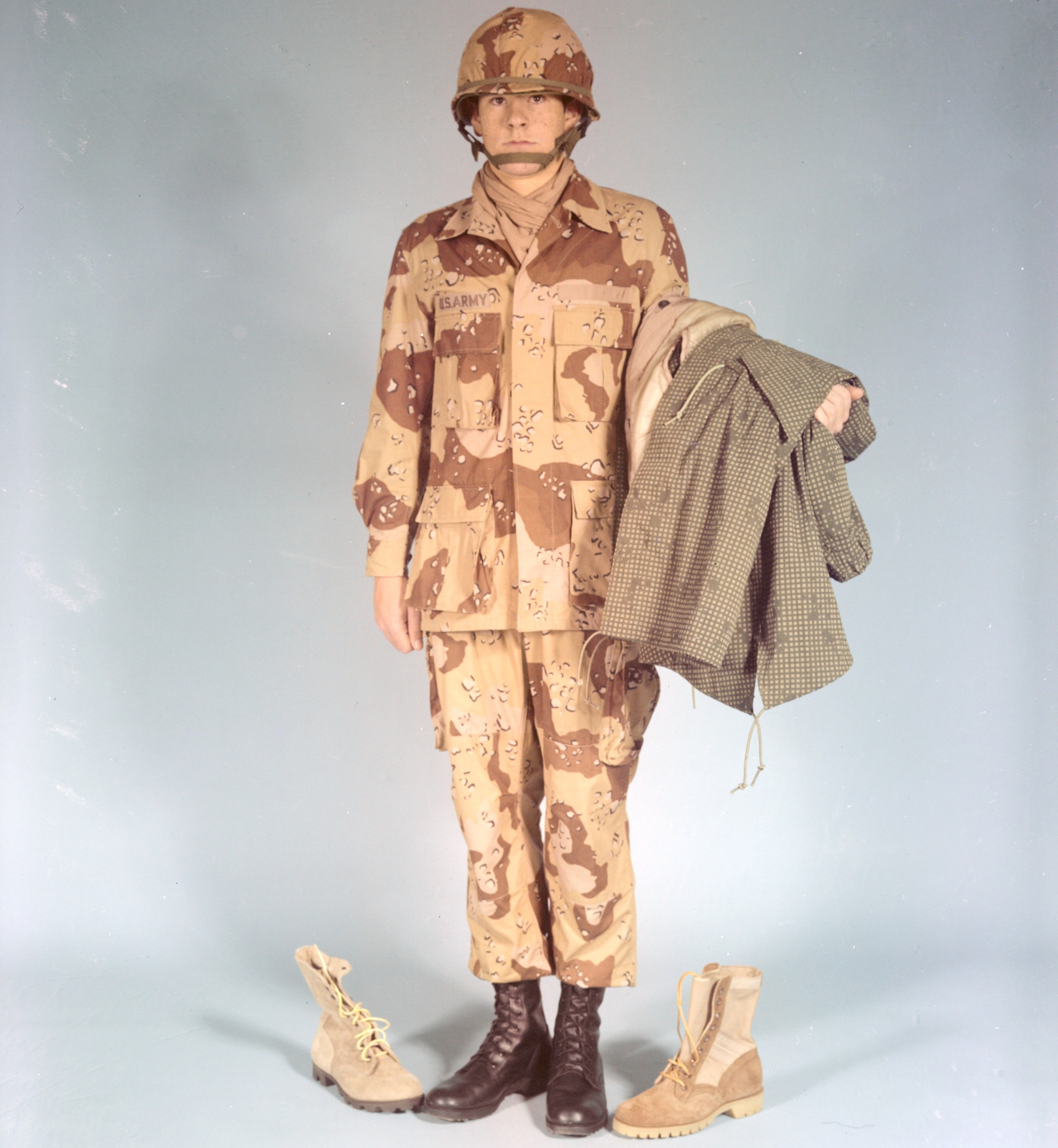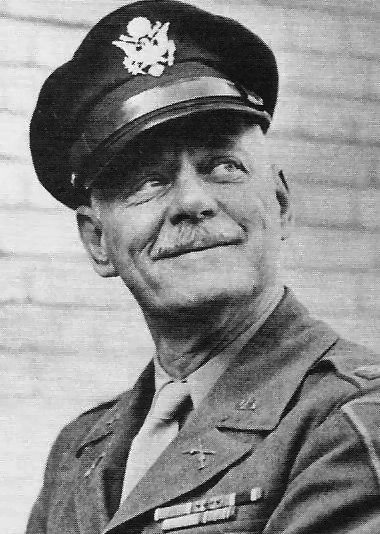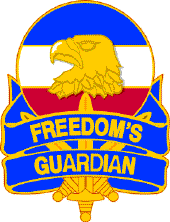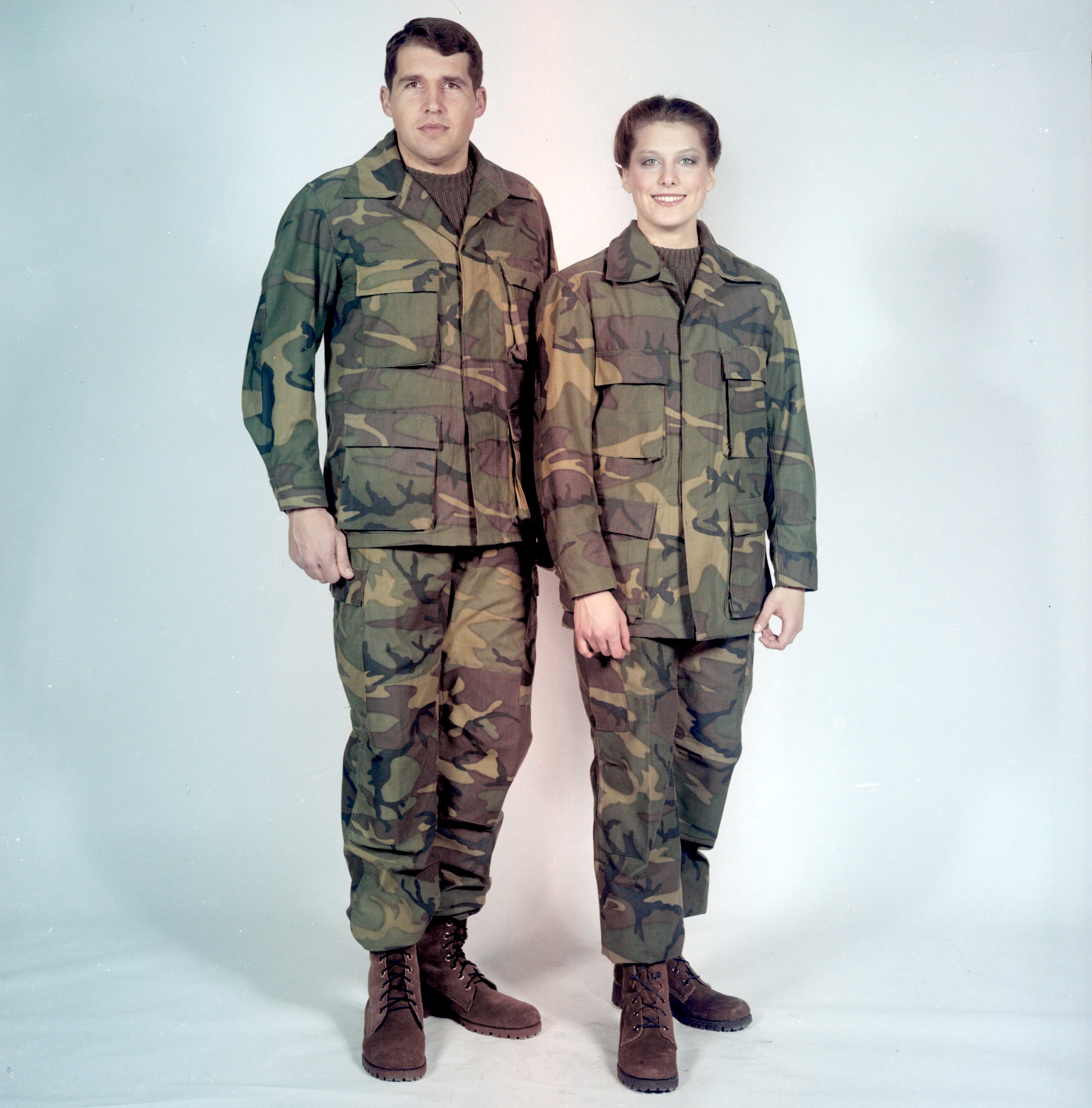|
Desert Battle Dress Uniform
The Desert Battle Dress Uniform (DBDU) is a U.S. arid-environment camouflage battle uniform that was used by the United States Armed Forces from the early 1980s to the early to mid 1990s, most notably during the Persian Gulf War. Although the U.S. military has long since abandoned the pattern, it is still in widespread use by militaries across the world as of the early 2020s. Appearance The Desert Battle Dress Uniform was designed in 1970 and uses a camouflage pattern known as the Six-Color Desert Pattern or colloquially as Chocolate-Chip Camouflage and Cookie Dough Camouflage. The camouflage received its nickname because it resembles chocolate-chip cookie dough. It is made up of a base pattern of light tan overlaid with broad swathes of pale green and wide two-tone bands of brown. Clusters of black and white spots are scattered over, to mimic the appearance of pebbles and their shadows. The cut of the DBDU is virtually identical to that of the Temperate BDU, retaining the ‘ ... [...More Info...] [...Related Items...] OR: [Wikipedia] [Google] [Baidu] |
Military Camouflage
Military camouflage is the use of camouflage by an Military, armed force to protect personnel and equipment from observation by enemy forces. In practice, this means applying colour and materials to military equipment of all kinds, including vehicles, ships, aircraft, gun positions and battledress, either to conceal it from observation (crypsis), or to make it appear as something else (mimicry). The French slang word ''wikt:camouflage, camouflage'' came into common English usage during World War I when the concept of visual deception developed into an essential part of modern military tactics. In that war, long-range artillery and observation from the air combined to expand the field of fire, and camouflage was widely used to decrease the danger of being targeted or enable surprise. As such, military camouflage is a form of military deception in addition to cultural functions such as political identification. Camouflage was first practiced in simple form in the mid 18th centur ... [...More Info...] [...Related Items...] OR: [Wikipedia] [Google] [Baidu] |
United States Rapid Deployment Forces
The Rapid Deployment Joint Task Force (RDJTF) is an inactive United States Department of Defense Joint Task Force. It was first envisioned as a three- division force in 1979 as the Rapid Deployment Force (RDF), a highly mobile rapid deployment force that could be rapidly moved to locations outside the normal overseas deployments in Europe and Korea. Its charter was expanded and greatly strengthened in 1980 as the RDJTF. It was inactivated in 1983, and re-organized as the United States Central Command (USCENTCOM). After the end of American involvement in the Vietnam War, U.S. attention gradually focused on the Persian Gulf region. The Yom Kippur War of 1973, the Soviet–U.S. confrontation, and the subsequent 1973 oil crisis led to President Richard Nixon issuing a warning that "American military intervention to protect vital oil supplies" was a possibility, served to increase attention on the area as being vital to U.S. national interests.Antill, P. (2001)Rapid Deployment Force, ... [...More Info...] [...Related Items...] OR: [Wikipedia] [Google] [Baidu] |
101st Airborne
The 101st Airborne Division (Air Assault) ("Screaming Eagles") is a light infantry division (military), division of the United States Army that specializes in air assault military operation, operations. The 101st is designed to plan, coordinate, and execute brigade-sized air assault operations that can be conducted in one period of darkness, at distances up to 500 nautical miles, to seize key terrain and hold it for up to 14 days. In recent years, the 101st was active in foreign internal defense and counterterrorism operations in Iraq, in Afghanistan in 2015–2016, and in Syria, as part of Operation Inherent Resolve in 2018–2021. Established in 1918, the 101st Division was first constituted as an airborne unit in 1942. During World War II, it gained renown for its role in Operation Overlord (the Normandy landings, D-Day landings and American airborne landings in Normandy, airborne landings on 6 June 1944, in Normandy, France); Operation Market Garden; the liberation of the ... [...More Info...] [...Related Items...] OR: [Wikipedia] [Google] [Baidu] |
82nd Airborne
The 82nd Airborne Division is an airborne infantry division of the United States Army specializing in parachute assault operations into hostile areasSof, Eric"82nd Airborne Division" ''Spec Ops Magazine'', 25 November 2012. Archived from thoriginalon 1 September 2017. with a US Department of Defense mandate to be "on-call to fight any time, anywhere" at "the knife's edge of technology and readiness."82nd Airborne Division United States Army, dated 16 May 2018. Retrieved 11 September 2018 Primarily based at Fort Bragg, North Carolina, the 82nd Airborne Division is part of the XVIII Airborne Corps. The 82nd Airborne Division is t ... [...More Info...] [...Related Items...] OR: [Wikipedia] [Google] [Baidu] |
Robert C
The name Robert is an ancient Germanic given name, from Proto-Germanic "fame" and "bright" (''Hrōþiberhtaz''). Compare Old Dutch ''Robrecht'' and Old High German ''Hrodebert'' (a compound of '' Hruod'' () "fame, glory, honour, praise, renown, godlike" and ''berht'' "bright, light, shining"). It is the second most frequently used given name of ancient Germanic origin.Reaney & Wilson, 1997. ''Dictionary of English Surnames''. Oxford University Press. It is also in use as a surname. Another commonly used form of the name is Rupert. After becoming widely used in Continental Europe, the name entered England in its Old French form ''Robert'', where an Old English cognate form (''Hrēodbēorht'', ''Hrodberht'', ''Hrēodbēorð'', ''Hrœdbœrð'', ''Hrœdberð'', ''Hrōðberχtŕ'') had existed before the Norman Conquest. The feminine version is Roberta. The Italian, Portuguese, and Spanish form is Roberto. Robert is also a common name in many Germanic languages, including En ... [...More Info...] [...Related Items...] OR: [Wikipedia] [Google] [Baidu] |
Norman Schwarzkopf
Herbert Norman Schwarzkopf Jr. ( ; 22 August 1934 – 27 December 2012) was a United States Army general. While serving as the commander of United States Central Command, he led all coalition forces in the Gulf War against Ba'athist Iraq. Born in Trenton, New Jersey, Schwarzkopf grew up in the United States and later in Iran. He was accepted by the United States Military Academy and was commissioned as a second lieutenant in the United States Army in 1956. After a number of initial training programs, Schwarzkopf interrupted a stint as an academy teacher and served in the Vietnam War, first as an adviser to the South Vietnamese Army and then as a battalion commander. Schwarzkopf was highly decorated in Vietnam and was awarded three Silver Stars, two Purple Hearts, and the Legion of Merit. Rising through the ranks after the Vietnam war, he later commanded the 24th Mechanized Infantry Division and was one of the commanders of the invasion of Grenada. Assuming command of Uni ... [...More Info...] [...Related Items...] OR: [Wikipedia] [Google] [Baidu] |
Saudi Arabia
Saudi Arabia, officially the Kingdom of Saudi Arabia (KSA), is a country in West Asia. Located in the centre of the Middle East, it covers the bulk of the Arabian Peninsula and has a land area of about , making it the List of Asian countries by area, fifth-largest country in Asia, the largest in the Middle East, and the List of countries and dependencies by area, 12th-largest in the world. It is bordered by the Red Sea to the west; Jordan, Iraq, and Kuwait to the north; the Persian Gulf, Bahrain, Qatar and the United Arab Emirates to the east; Oman to the southeast; and Yemen to Saudi Arabia–Yemen border, the south. The Gulf of Aqaba in the northwest separates Saudi Arabia from Egypt and Israel. Saudi Arabia is the only country with a coastline along both the Red Sea and the Persian Gulf, and most of Geography of Saudi Arabia, its terrain consists of Arabian Desert, arid desert, lowland, steppe, and List of mountains in Saudi Arabia, mountains. The capital and List of cities ... [...More Info...] [...Related Items...] OR: [Wikipedia] [Google] [Baidu] |
Iran
Iran, officially the Islamic Republic of Iran (IRI) and also known as Persia, is a country in West Asia. It borders Iraq to the west, Turkey, Azerbaijan, and Armenia to the northwest, the Caspian Sea to the north, Turkmenistan to the northeast, Afghanistan to the east, Pakistan to the southeast, and the Gulf of Oman and the Persian Gulf to the south. With a Ethnicities in Iran, multi-ethnic population of over 92 million in an area of , Iran ranks 17th globally in both List of countries and dependencies by area, geographic size and List of countries and dependencies by population, population. It is the List of Asian countries by area, sixth-largest country entirely in Asia and one of the world's List of mountains in Iran, most mountainous countries. Officially an Islamic republic, Iran is divided into Regions of Iran, five regions with Provinces of Iran, 31 provinces. Tehran is the nation's Capital city, capital, List of cities in Iran by province, largest city and financial ... [...More Info...] [...Related Items...] OR: [Wikipedia] [Google] [Baidu] |
Operation Eagle Claw
Operation Eagle Claw ( Persian: عملیات پنجه عقاب) was a failed U.S. Department of Defense attempt to rescue 52 embassy staff held captive by Revolutionary Iran on 24 April 1980. It was ordered by US President Jimmy Carter after the staff were seized at the Embassy of the United States, Tehran. The operation, one of Delta Force's first, encountered many obstacles and failures and was subsequently aborted. Eight helicopters were sent to the first staging area called ''Desert One'', but only five arrived in operational condition. One had encountered hydraulic problems, another was caught in a sand storm, and the third showed signs of a cracked rotor blade. During the operational planning, it was decided that the mission would be aborted if fewer than six helicopters remained operational upon arrival at the Desert One site, despite only four being absolutely necessary. In a move that is still discussed in military circles, the field commanders advised President Ca ... [...More Info...] [...Related Items...] OR: [Wikipedia] [Google] [Baidu] |
FORSCOM
The United States Army Forces Command (FORSCOM) is the largest command of the United States Army. It provides land forces to the Department of Defense's unified combatant commands. FORSCOM is headquartered at Fort Bragg, North Carolina, and consists of more than 750,000 active Army, U.S. Army Reserve, and Army National Guard soldiers. It was created on 1 July 1973 from the former Continental Army Command (CONARC), which in turn supplanted Army Field Forces and Army Ground Forces. The command has formations and units located at 15 installations, including the National Training Center at Fort Irwin, California and the Joint Readiness Training Center at Fort Johnson, Louisiana (the former Fort Polk). History In 1942, the Army was divided between Army Ground Forces; Army Service Forces; and the Services of Supply. On 30 August 1945, Army Chief of Staff General George Marshall created a board headed by Lieutenant General Alexander M. Patch to review the organization of ... [...More Info...] [...Related Items...] OR: [Wikipedia] [Google] [Baidu] |
Operation Bright Star
Exercise Bright Star is a series of biennial combined and joint military exercises led by the United States and Egypt. The exercises began in 1980, rooted in the 1977 Camp David Accords. After its signing, the United States Armed Forces and the Egyptian Armed Forces agreed to conduct training together in Egypt. Bright Star is designed to strengthen ties between the Egyptian Armed Forces and the United States Central Command and demonstrate and enhance the ability of the Americans to reinforce their allies in the Middle East in the event of war. These deployments are usually centered at the large Cairo West Air Base. Since the Gulf War, the end of NATO's Cold War-era Reforger exercises, and the wars in Iraq and Afghanistan, Bright Star exercises have grown larger and have included as many as 11 countries and 70,000 personnel. Other allied nations joining Bright Star exercises in Egypt include the United Kingdom, France, Germany, Italy, Greece, the Netherlands, Jordan, Kuwait ... [...More Info...] [...Related Items...] OR: [Wikipedia] [Google] [Baidu] |
Battle Dress Uniform
The Battle Dress Uniform (BDU) is a camouflaged combat uniform that was used by the United States Armed Forces as their standard combat uniform from the early 1980s to the mid-2000s. Since then, it has been replaced or supplanted in every branch of the U.S. Armed Forces. BDU-style uniforms and derivatives still see widespread use in other countries (some of them being former U.S. surplus stocks transferred under U.S. security assistance programs), while others are still worn by some U.S. federal, state, and local law enforcement in the United States, law enforcement agents who may work in tactical situations, such as the Drug Enforcement Administration#Special Response Teams, DEA RRT and SWAT teams. The uniforms are also used by urban search and rescue groups such as FEMA Urban Search and Rescue Task Force, FEMA USAR task force teams and firefighting agencies when conducting technical rescues or other special operations. As late as 2014, BDUs were worn by officers of the Unit ... [...More Info...] [...Related Items...] OR: [Wikipedia] [Google] [Baidu] |






